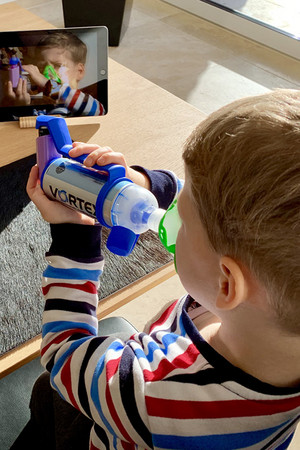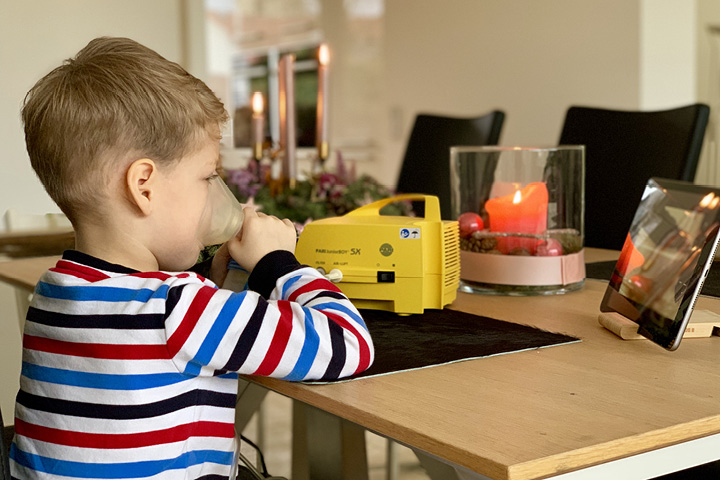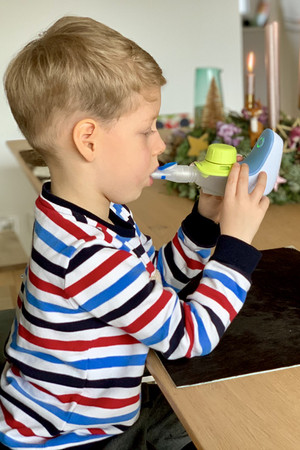Justus is 4-years-old. Even as a baby, he regularly suffered from breathlessness and acute bronchitis. Finally there was a diagnosis: Justus has a number of food allergies that trigger asthma. He is also developing chronic bronchitis. “We started the therapy when he was six months old”, his mother Julia reports. “By strictly avoiding the allergens, we can prevent the asthma attacks, but his lungs are still really sensitive to any kind of irritation.”

To get his lung problems under control, twice a day Justus has to inhale a spray containing cortisone and an active substance that expands the airways, reports his mother. To do this, he uses a holding chamber. “There are no problems with the inhalation and handling the holding chamber. It would be difficult without the holding chamber. It is difficult for a child to properly manage the breathing manoeuvre required for inhaling with a metered dose inhaler Because you have to breathe in deep just as the spray is released. Justus would not be able to manage that without the holding chamber. With the holding chamber you don’t have to synchronise pressing the spray and breathing in because the medication is collected in the chamber. Justus can inhale the medication for several breaths. That way we are sure that it is actually reaching his lungs where it can do its job”, says Julia.
She is convinced that her son can only rough and tumble like any other child despite his asthma and chronic bronchitis because he regularly inhales his medications. Some parents are hostile to the idea of inhalation. Julia can’t understand why and explains her reasoning: “We went to a rehabilitation clinic with Justus where they told us: “Put a straw in your mouth and try just breathing through the straw. That’s what breathing feels like for your children when their airways are tight and blocked with mucus and they are not given medication.” I tried it. It feels as if you are on your last legs. It is a strain and it’s exhausting. Who would want to put their child through that? That is why we do the inhalation. I want my child to have a high quality of life and to be able to rough and tumble through the day.” Experience has shown Julia that Justus also gets a lung infection the minute he stops regularly inhaling with the spray.
Cold and damp weather also takes it out of little Justus. “The minute it is wet and cold, Justus starts to struggle. The next infection is then inevitable. As soon as the first signs of deterioration in his breathing appear, we add moist inhalation to the metered dose aerosol using an inhalation device with a nebuliser. Justus has developed a keen sense of his own body, even though he is still very little. He notices very quickly if there is a build-up of mucus in his lungs. Then he comes to me and says: Mummy, I want to inhale with the PARI Boy.” He feels that the inhalation with the 3% hypertonic saline solution does him good, that the phlegm loosens and that he can breathe normally. By inhaling with saline solution in time we can get a grip on the infection so it is only mild and he can still exert himself physically, like a perfectly healthy child”, explains Justus’ mother.
While inhalation is good, it is not a bundle of fun for many children. Inhalation can then become a conflict between parents and children. Instead of arguing about it, there is a little trick that helps, as Julia knows from her own experience: “Of course, at the beginning, we had a job persuading Justus to do the inhalation therapy. Then we came up with a trick where he can watch TV during the inhalation. That’s his reward. Since then we don’t need to argue about it and we know that he sticks it out for the whole inhalation time and doesn’t want to stop early. Every child will use a nebuliser if there is a reward in it for them, instead of telling them off if they don’t want to do it.”


If you invest time in a therapy, it should obviously be as effective as possible. When buying the inhalation device, the droplet size was what counted for Julia. Only if the device or the nebuliser generates the right droplet size can saline solutions and medications reach the patient’s bronchial tubes. Otherwise, they don’t get any further than the mouth and throat. “I know that doctors are sometimes reluctant to prescribe the PARI BOY before it is expensive compared to other devices. But I did loads of research and wanted the device with the optimum droplet size. After all, I want my child to get something out of the inhalation”, explains the mother. Justus was prescribed the PARI BOY and a while later the VELOX. The VELOX for inhalation therapy is smaller and lighter than the classic BOY; it is barely audible and also runs on batteries. This is why the family takes this one when they travel. Julia says: “Our equipment also includes an O-PEP respiratory therapy device. Justus uses this whenever we have the feeling that the mucus is well and truly stuck in his lungs. With our equipment we are well-positioned to manage day-to-day life and times when Justus is struggling with asthma and bronchitis. The therapeutic measures mean that Justus can lead a carefree life and we can too, as parents.”
Note: The statements made in the report are the individual view of the person reporting. They do not necessarily reflect the PARI view or the general state of science.
An article written by the PARI BLOG editorial team.
© 2025 PARI GmbH Spezialisten für effektive Inhalation